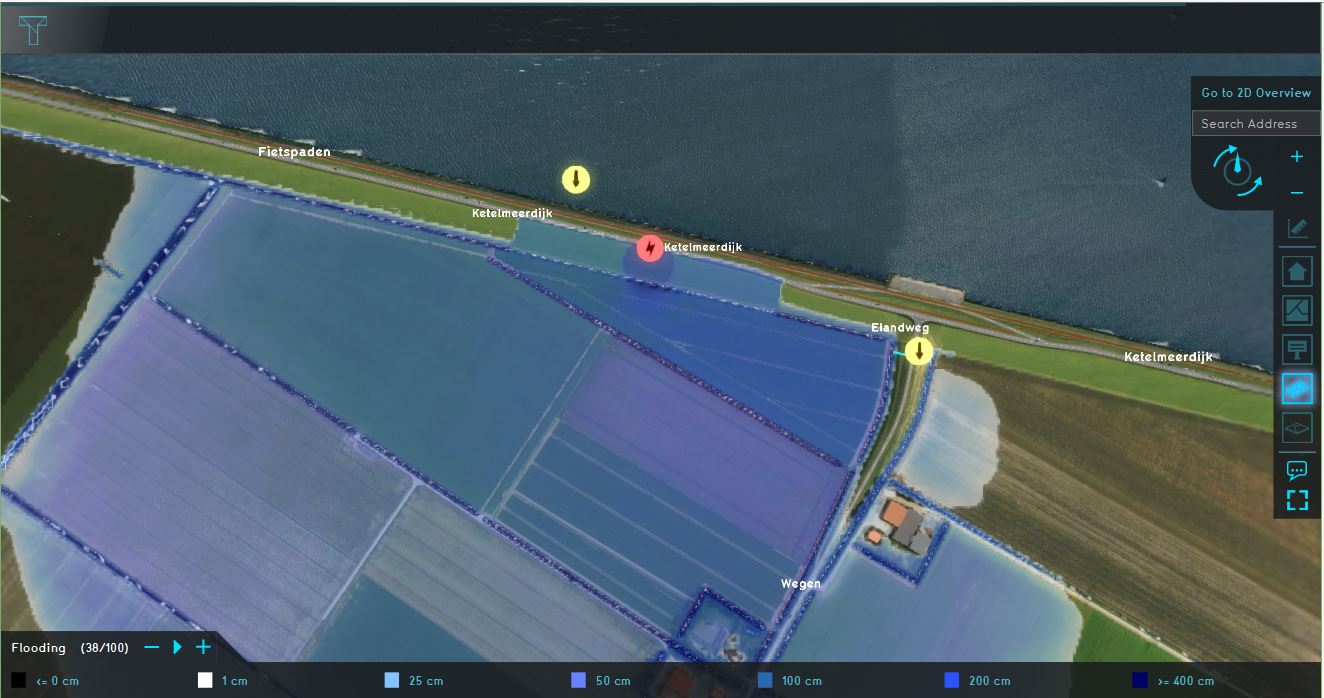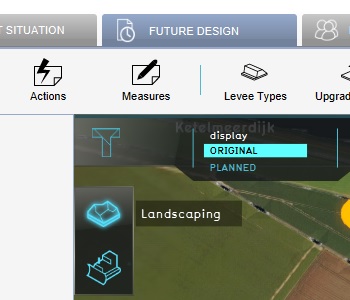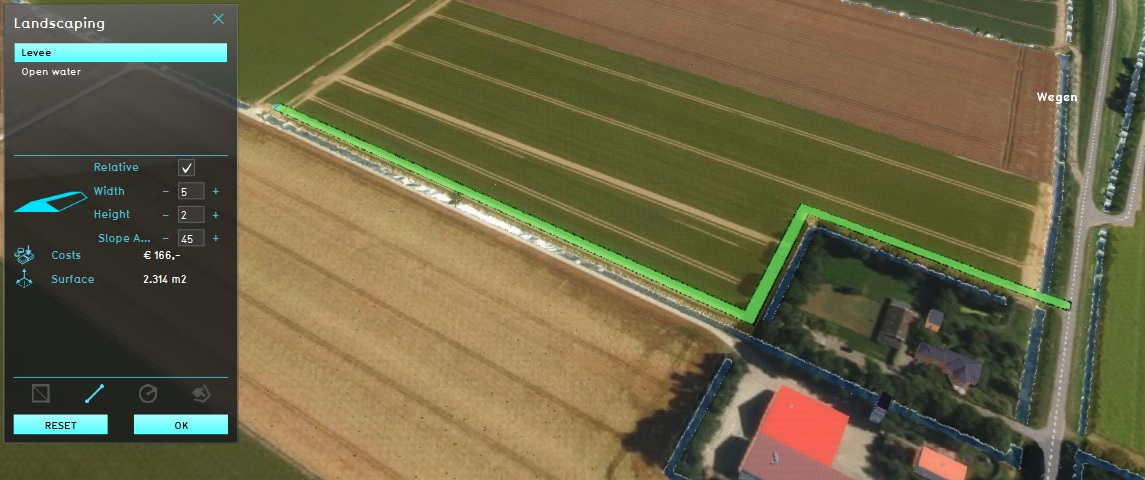Demo Breach Project
| Next page>> |

The Demo Breach project is available for all users and can be found in the main menu under Edit projects. This project does not count towards your license.
This project is intended for hydrologists and other water experts.
This project showcases the flooding overlay in a basic setup with a breach.
The demo is a working project in which a location in The Netherlands experiences a breach in a levee holding back a large amount of water. It can serve to explore how breaches are modeled in the Water Module, how they are configured, and how the consequences of a flooding can be analysed. The project simulates a breach which grows over time, allowing as much water to flow through as the lake contains and the dynamic size of the breach allows over a 30 minute period.
Exploring the project
To begin exploring the project, take the following steps:
- Click anywhere in the 3D world, and use the arrow keys on your keyboard to move around in the world. You can also drag the camera around by right-clicking (and holding the right mouse button down) in the 3D world and dragging the world around. Use the scroll wheel to zoom in- and out.
- On the right-hand side of the 3D world you can see the overlays menu. Hover over the various icons to see a tooltip with their name. Find the overlay named "Flooding", and click on it. This will show the overlay in the 3D world. This overlay shows the amount of water in the world during the flooding simulation.
- At the bottom of the interface a legend will now appear, with on the left-hand side of the legend a few buttons to "play" the overlay. Zoom out so that you can see a large swat of land, and click on the "play" button. You will see how the state of the water changes over time.
- Hover over the icon for the overlay again, and notice that more options appear for overlays related to flooding. These are the child overlays, which can display more types of results from the flooding simulation.
- Finally, notice a number of icons floating in the world. The orange icons are of particular note; these denote points-of-interest which you can take a closer look at. You can click on any to open a panel with more information.
Points of interest
Breach

A levee exists between the large lake to the north, and the farms and small groups of buildings to the south. On this levee, an "Area" has been drawn to represent the point of a breach. The properties of the breach are defined as attributes of the drawn Area. The breach starts small, but as part of the simulation, it will grow over time, allowing more water to flood in.
Clicking on the popup will show the Base Types overlay, which shows what features are present in the 3D world for the purpose of the flooding simulation.
Elevation

At the location of the elevation popup, some subtle variety exists in the height of the terrain, causing water to flow around certain plots before enough water builds up to flow over it. This makes some locations more suitable as temporary safe locations or evacuation routes.
Culvert

The construction popup in the project indicates the locations of a culvert. The culvert allows water to flow through whenever water exceeds its bottom height. This allows water from the breach to flow past (or rather through) the inner levee at thus specific point.
Flowthrough is effectively only by the diameter of the culvert. Flowthrough is calculated by the culvert formula. To see how a culvert is configured, navigate to the following location in the editor:
In the wizard, click on "Next" until you reach the step on "Culverts". There, select the culvert to inspect its attributes. Additionally, you can select "Show in Editor" to have the 3D world zoom to its location.
External Water Area

The faucet popup in the project indicates the canonical location of the water which floods into the project area. However, the lake is much larger than what is included in the project. This would mean that if the water truly flowed from this location to everywhere else in the project, there would be significantly less water flowing in through the breach, and thus the impact of the flooding would be diminished. Instead, the breach has been configured with a virtual representation of an external source of water, with the dimensions of the real lake as its configuration.
To see how the breach is configured, navigate to the following location in the editor:
In the wizard, click on "Next" until you reach the step on "Breach areas". There, select the breach to inspect its attributes. The following attributes define the virtual external water area:
Measurement tool

More in-depth analysis of water in the project can be achieved using the Measuring tool. Go to the X popup in the project, and place a point measurement anywhere to see a graph of the waterlevels in that location during the simulation.
You can also place a line measurement, perpendicular across one or multiple features of varying elevation. You can get a cross-section of the waterlevels relative to datum by doing the following:
- Select the flooding overlay
- Place a line measurement
- In the "Base" Overlay dropdown, select the "Surface Elevation.
- Check the "Sum" option, to add the values of the two layers together
- Select the "Fit to graph" mode to use the full extent of the measuring window.
The result is a cross-section of the water and the terrain height.
Actions

After inspecting the consequences of the defined rainfall, it is possible to explore potential remedies. Note that when any of the actions described here are taken, a testrun will start. This means the editing tools will be temporarily disabled. When you are done experimenting with actions, you can stop the testrun by clicking the stop button in the ribbon. This will revert the session back to its base state, without the effects of the applied action(s).
Levee


Switch to the "Future design" tab, and then in the 3D interface the action menu will appear. Open the menu with "Landscaping" options, and select the "Levee" action. You are now able to draw a line which will be the site of a new levee. Draw one or more lines in a protective formation near one of the farms which is affected by the flood. When you have made the selection, select "Confirm". This will create a new levee, which will block water flowing across the land.
After making the change, the flooding overlay will be recalculated, and the new results will indicate how water would act with the new levee. In all probability, the levee will not stop all the water permanently, but may serve to delay the water, granting more time for people to prepare or evacuate. At the top of the interface, in the Top bar, find the "display" option, and select the "Current" mode. This will display the results of the original calculation. Activate the flooding overlay and find the moment in time where the water surrounds the farm. Now switch the display mode to "Planned". This will show the results of the overlay based on the effects of the levee. If the levee is effective, the new results will show the farm less (or not yet) affected by the water at the same moment in time. Forward the overlay result slightly to see the new moment where the farm is affected. All time in between is evacuation time gained by creating a levee in well-conceived location.
| Next page>> |